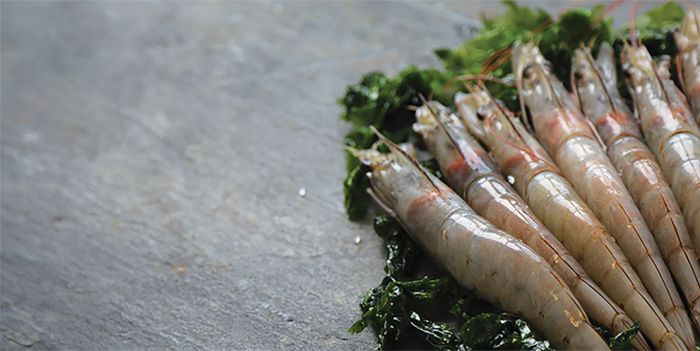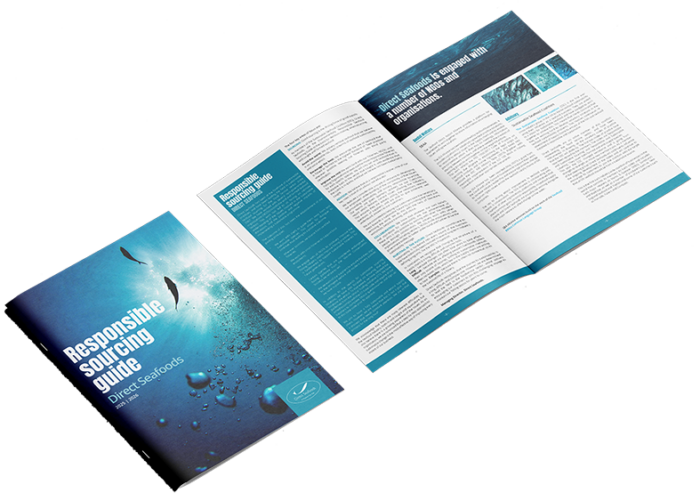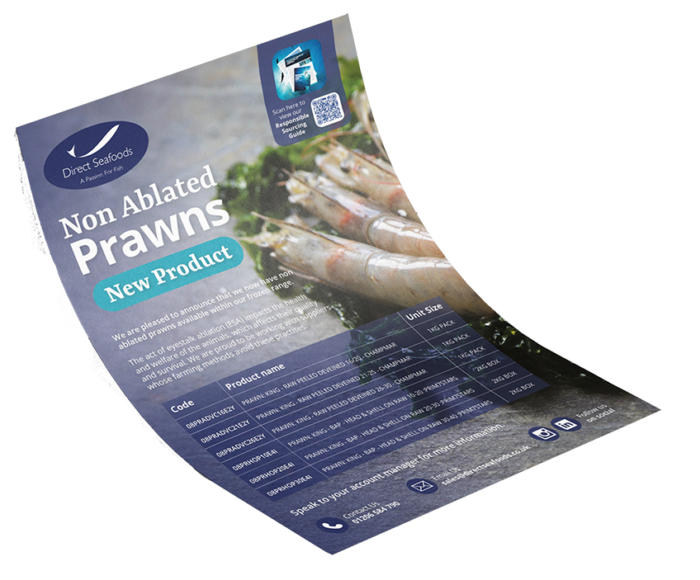Eye Ablation in Prawn and Shrimp Farming: What is wrong with it?
As a company committed to sustainable seafood sourcing, we recognise our responsibility to ensure ethical and environmentally sound practices in aquaculture. One such issue that is causing increased attention from the industry is the practice of eye ablation in prawn and shrimp farming. This treatment method does not promote animal welfare or truly responsible seafood production.
What Is Eye Stalk Ablation?
Eye stalk ablation is the process of removing or crushing one or both eyestalks of female prawns and shrimp in the broodstock. This is done to accelerate reproduction, as the removal of the eyestalk triggers hormonal changes that induce faster and more frequent egg production. While this practice has been used for decades to increase yields in shrimp hatcheries, it raises significant ethical and sustainability concerns.

The Ethical and Welfare Concerns
‣ Severe Pain and Stress – Research indicates that crustaceans, including shrimp and prawns, experience pain and stress. Eye ablation is a traumatic procedure that causes immediate and prolonged suffering, compromising the overall well-being of the animal. A study published in the journal Applied Animal Behaviour Science found that shrimp subjected to eyestalk ablation exhibit significant behavioural and physiological stress responses.
‣ Shortened Lifespan and Health Issues – Prawns subjected to eye ablation often exhibit weakened immune systems, making them more susceptible to disease outbreaks. This can lead to higher mortality rates and increased antibiotic use, further threatening sustainability. In some studies, mortality rates of ablated shrimp have been reported to be as high as 50% in certain hatchery settings.
‣ Reduced Quality and Natural Behaviour – The practice alters natural reproductive behaviours and can negatively affect the quality of larvae produced, leading to lower survival rates and potential genetic issues in subsequent generations. A 2019 report indicated that naturally bred shrimp had up to 30% higher survival rates compared to those from ablated females.
Sustainability and Industry Responsibility
Beyond ethical concerns, eye ablation contradicts the principles of responsible aquaculture:
‣ Market Demand for Ethical Seafood – Consumers and businesses increasingly demand higher welfare standards in seafood sourcing. As awareness grows, foodservice providers must respond by sourcing from farms that use humane breeding techniques. A recent survey found that up to 85% of UK consumers prefer seafood that adheres to higher welfare standards.
‣ Better Alternatives Exist – Progressive hatcheries are now using alternative breeding techniques, such as improved broodstock management, environmental conditioning, and natural hormonal stimulation, which allow prawns to spawn without the need for eye ablation. Some hatcheries in Southeast Asia and Latin America have successfully eliminated eye ablation while maintaining production yields.
‣ Aligning with Certification Standards – Sustainable seafood certifications, such as the Aquaculture Stewardship Council (ASC) and Best Aquaculture Practices (BAP), are beginning to address welfare concerns, encouraging farms to move away from eye stalk ablation. Several ASC-certified farms have already committed to phase out the practice.
What Can You (customer) Do?
If you are a chef, restaurant owner, or contract caterer, here’s how you can play a key role in eliminating eye ablation from the supply chain:
‣ Source Responsibly – Work with suppliers that prioritize ethically farmed prawns and shrimp. Ask your seafood suppliers about their stance on eye ablation and whether they source from farms using humane breeding techniques.
‣ Look for Certified Products – Choose shrimp and prawns that carry certifications from organizations like the Aquaculture Stewardship Council (ASC) or Best Aquaculture Practices (BAP), which are beginning to address this issue.
‣ Educate Your Customers – Inform diners about the importance of ethical seafood choices. Adding information to menus or marketing materials about sustainable and welfare-friendly seafood practices can drive awareness and demand for responsible sourcing.
‣ Advocate for Change – Engage with industry groups and suppliers to push for higher welfare standards. Your influence as a buyer can encourage more producers to move away from harmful practices.

*Direct Seafoods Responsible Sourcing Guide 25/26

*Non-ablated prawns to our product range
Our Commitment: Introducing Non-Ablated Prawns
As part of our commitment to driving industry change, we are excited to introduce a limited selection of non-ablated prawns to our product range. These prawns are sourced from responsible hatcheries that prioritize ethical breeding techniques, ensuring higher welfare standards without compromising quality. By offering these alternatives, we aim to demonstrate that sustainable and humane seafood sourcing is not only possible but also commercially viable.
We encourage our customers to support this initiative by considering non-ablated prawns for your menus and discussing your requirement with your account manager. Increased demand for ethically farmed seafood will send a strong message to producers and accelerate the shift toward better practices in the industry.
Please note that we are only able to hold a limited range and quantity of these prawns until such a time that we see the demand to enable more volume commitment. Please do talk to your account manager about the viability of a switch. Any significant confirmed requirement will support an increased range and continuity of supply.
Summary
Progress in the phasing out of eye stalk ablation in shrimp and prawn farming is an important step towards a more sustainable and ethical seafood industry, but there is still a long way to go. Real change will require collaboration across the entire supply chain, from producers and suppliers to foodservice and consumers. By supporting responsible sourcing and advocating for higher welfare standards, we can help drive the industry in the right direction. Together, we can make meaningful progress toward better practices and a more sustainable future.
Please speak to your account manager for more info


